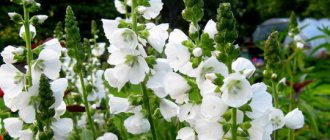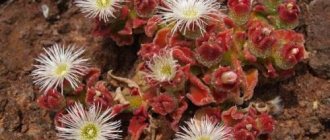The most famous varieties and varieties of plants
The magnificent herbaceous plant salpiglossis is known to many gardeners under the name “pipetongue”. It can transform any garden plot beyond recognition: make it beautiful and fragrant. Its gorgeous velvet flowers, about 6 cm in diameter, look like large bells of various shades (from yellow, white to blue), the leaves are alternate, whole or pinnately incised.
Salpiglossis has very bright flowers with a strong aroma
The plant can reach a height of 15 cm to 1 m and blooms from early summer to mid-autumn. It is an annual and perennial (biennial) species native to South America. The presented photo will convey to you all its magical beauty.
The family of this plant consists of about 20 unique species, among which there are annual and perennial salpiglossis.
Its most popular species is considered to be salpiglosis notched . Its thin stems, covered with sticky hairs, can reach up to 1 m in height. It has wavy or toothed leaves and velvety, funnel-shaped flowers with five petals. The versatility of the color of the notched salpiglossis is also pleasing to the eye. A luxurious representative of this species is shown in the following photo.
Salpiglosis notched
Most often, the following varieties of notched salpiglossis are found:
- low (its branching bushes reach only 40 cm in height, it has lush flowering);
- large-flowered (tall variety covered with large flowers);
- superbyssima (the variety is distinguished by beautiful corrugated flowers and non-branching stems).
Growing
Salpiglossis is grown from seeds. They can be sown in early spring or early autumn, then the plants will bloom in summer or early spring, respectively. Seedlings are picked, planted in a flower garden, greenhouse or in separate pots.
As they grow, thin stems are tied to a support. After flowering, the seeds are collected, since in our latitudes it is an annual plant.
Prefers light, water- and breathable soil with a high layer of drainage.
The plant also needs complex fertilizing for flowering plants. It will be enough to fertilize once a month. If Salpiglossis grows in a flower garden, two or three feedings will be enough for it during the entire period of active growing season.
Planting and caring for salpiglossis
First of all, you should choose the right place for the plant. A shaded area that will be well protected from sharp gusts of wind is ideal. Fertile soil rich in humus can ensure rapid growth of salpiglossis.
Planting of Tubetongue in open ground begins in early May, after the end of the last night frosts. Initially, a week before planting, the ground is dug up with added ash, a small amount of peat and sand. This plant loves neutral and slightly acidic soils.
A shady place is suitable for growing salpiglossis.
In the selected area, holes are made up to 2.5 cm deep, placed at a distance of 25 cm from each other. Seeds are sown in them, lightly sprinkled with a thin layer of soil and watered with water.
Provide the plant with moderate watering. A lack of moisture will lead to a decrease in the abundance of flowering and a decrease in growth activity, and its excess can cause rotting of the plant’s root system. In the summer season, the plant requires daily watering and spraying, and in the fall and spring two or three procedures per week will be enough for it.
It is very important to follow the watering schedule
In order for salpiglossis to delight you with constant flowering, remove dried flowers from it in a timely manner. Fresh buds will soon appear in their place. Also for this purpose, clothespins are formed.
Attention! If you are growing varieties with tall, thin stems, provide them with support. This will prevent the plants from breaking.
How to collect your seeds
Varietal plants produce viable seeds and can be used for further planting. When an oval capsule with many seeds ripens, it peels off and the seeds fall to the ground. To prevent this from happening, you can tie the testes with gauze and let them ripen on the mother plant. Or pick the darkened seed pod along with the shoot, let it ripen in a well-ventilated, shaded place, and then separate the seeds from the husk. They can be stored for up to 4 years, during which time the seeds retain excellent germination.
Reproduction and feeding of plants with fertilizers
You can’t even imagine what tremendous pleasure the mind-blowing salpiglossis will bring you. Growing a crop from seeds can be done in two ways:
- seedlings;
- seedless.
Salpiglossis grown by seedlings will bloom faster.
The most suitable time for germinating seeds is March. Wide and shallow containers are used for planting them. Seeds should be sown individually in loose and moist soil. After this, the container with the seedlings is covered with glass and placed on a well-lit windowsill.
Advice. To make seedlings germinate faster, place a white sheet of paper on top of the glass. This way the seedlings will be provided with the necessary amount of sunlight and protected from direct sunlight.
For the first two weeks, you need to periodically ventilate the container with seedlings and remove condensation. Shoots will appear in 10-15 days. When the first leaves appear, the seedlings dive into separate cups.
Attention! Replant seedlings very carefully, as their root system is very fragile.
Pinch the tops of the sprouts several times to help them develop faster. Do not forget about moderate watering of plants. At the end of May, seedlings can already be planted in open ground. Planted salpiglossis should bloom at the end of June.
However, the seeds of the plant can be planted immediately in open ground; this is usually done in early May. But in this case, salpiglossis will show you its flowering only in the second half of summer. Its seeds are sown in loose, moistened and prepared soil, in shallow holes. They are covered with earth and watered.
Adding mineral fertilizers will benefit salpiglossis
Seed germination rate is quite high. When the sprouts reach 4 cm in height, they should be thinned out a little.
Salpiglossis responds well to the application of mineral fertilizers. Such feeding should be done about twice a week. This procedure is especially important during the flowering period of the plant. This will enrich the soil and contribute to the active development of the tubal tongue.
As you can see, the plant does not require special care; it will not take up a lot of your free time and effort.
Sowing seeds in open ground (timing, place, sowing)
In the south, where winters are mild, short and warm, salpiglossis is planted directly into the soil on the site, skipping the stage of growing seedlings. Many gardeners prefer late autumn sowing before winter (after mid-November), then the seeds are naturally stratified in the cold outside. Very early spring planting in still cold soil is also possible (second half of February). It is permissible to sow salpiglossis at a later date - at the end of April or during the May holidays, but then flowering will begin no earlier than mid-July.
A place for organizing a flower bed is selected that is well-warmed and sunny, but protected from strong gusty winds, because the stems of salpiglossis are fragile and easily break off. It is advisable to avoid the proximity of large trees and shrubs; in their dense shade, this crop blooms much more modestly and develops more slowly. Areas that are swampy, heavily shaded, low-lying and damp with dense, poorly permeable clay soil are also not suitable.
The soil in the flowerbed is dug up in advance, immediately selecting stones and roots of perennials, and simultaneously adding complex mineral fertilizers for garden flowering crops with the necessary set of basic ingredients. Salpiglossis seeds are placed on the bottom of pre-made grooves to a depth of no more than 1 cm, then sprinkled with fertile soil mixture. The flowerbed is thoroughly watered and sprinkled with a layer of mulch.
Dangerous diseases and pests
The most dangerous pest for salpiglossis is the aphid. As soon as you notice plants damaged by it, treat them with an insecticidal composition. In addition, the danger is infection by a fungus, from which the plant begins to change its color, rot and may completely die. For prevention in this case, it is recommended to treat the soil with a fungicide.
Regularly inspect the plant for pests.
Difficulties
The plant is not capricious in general, but like any guest from warm countries, it does not have very strong immunity and can be affected by diseases and pests:
- Fungal diseases. If you find spots on the stems or leaves, all affected areas should be removed and the plants treated with a fungicide. If the plant is severely affected, it is better to completely destroy it so as not to risk other specimens. Prevention: planting seeds in sterilized soil, treating seedlings with a fungicide.
- Aphid. To get rid of it there are a number of folk remedies, as well as insecticides.
Fantastic variety 'Kew Blue'
Salpiglossis: combination with other plants and use in landscape design
The attractive appearance and fairly simple care of salpiglossis could not be ignored by modern landscape designers.
The plant makes excellent combinations with salvias, petunias, cynariums and marigolds. It also looks very impressive against the background of various coniferous plants. Its azure, lilac, blue, violet, white, yellow, gold and dark brown tones will fill any flowerbed with bright colors and will cause a lot of admiring glances.
Salpiglossis in landscape design
You can see the wonderful options for using salpiglossis in landscape design in the following photos.
By planting bright salpiglossis on your site, you will fill the surrounding exterior with harmony and comfort, making it stylish, neat and well-groomed.











